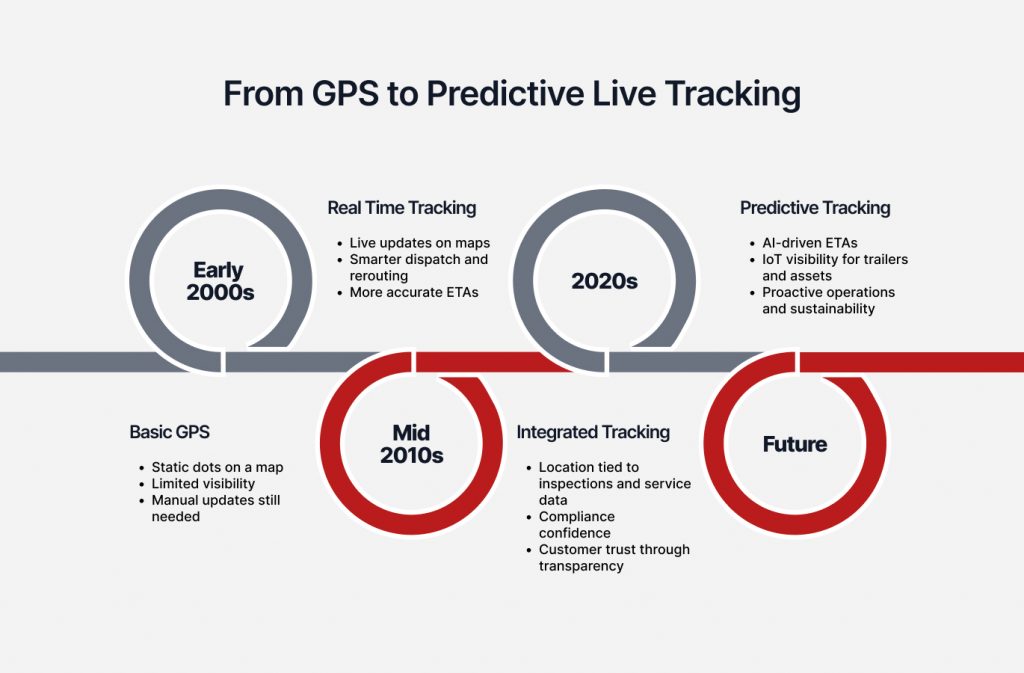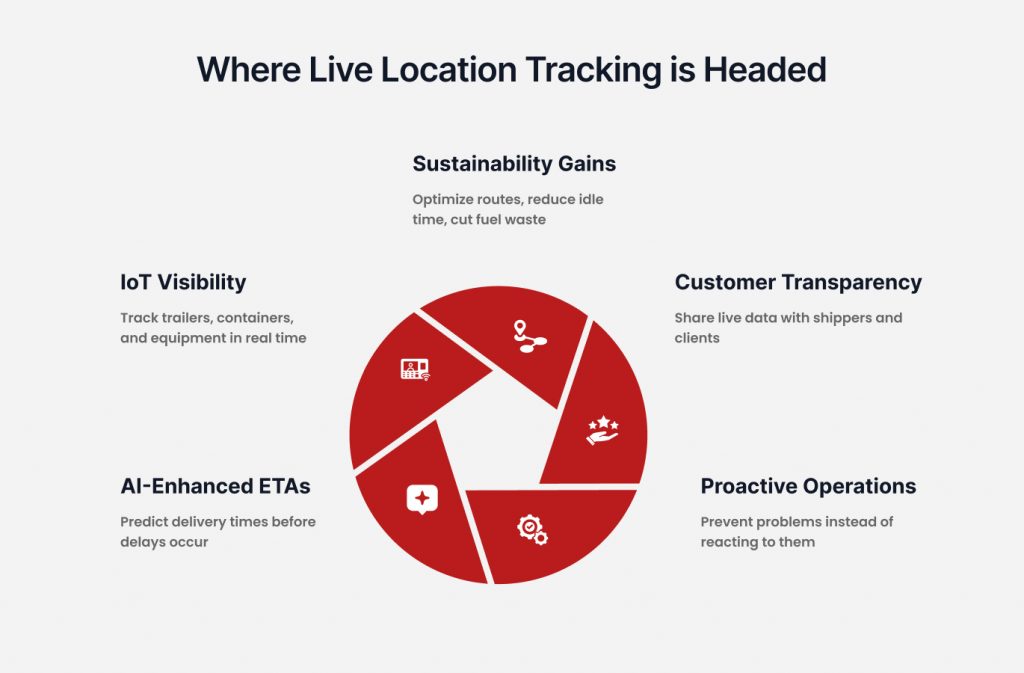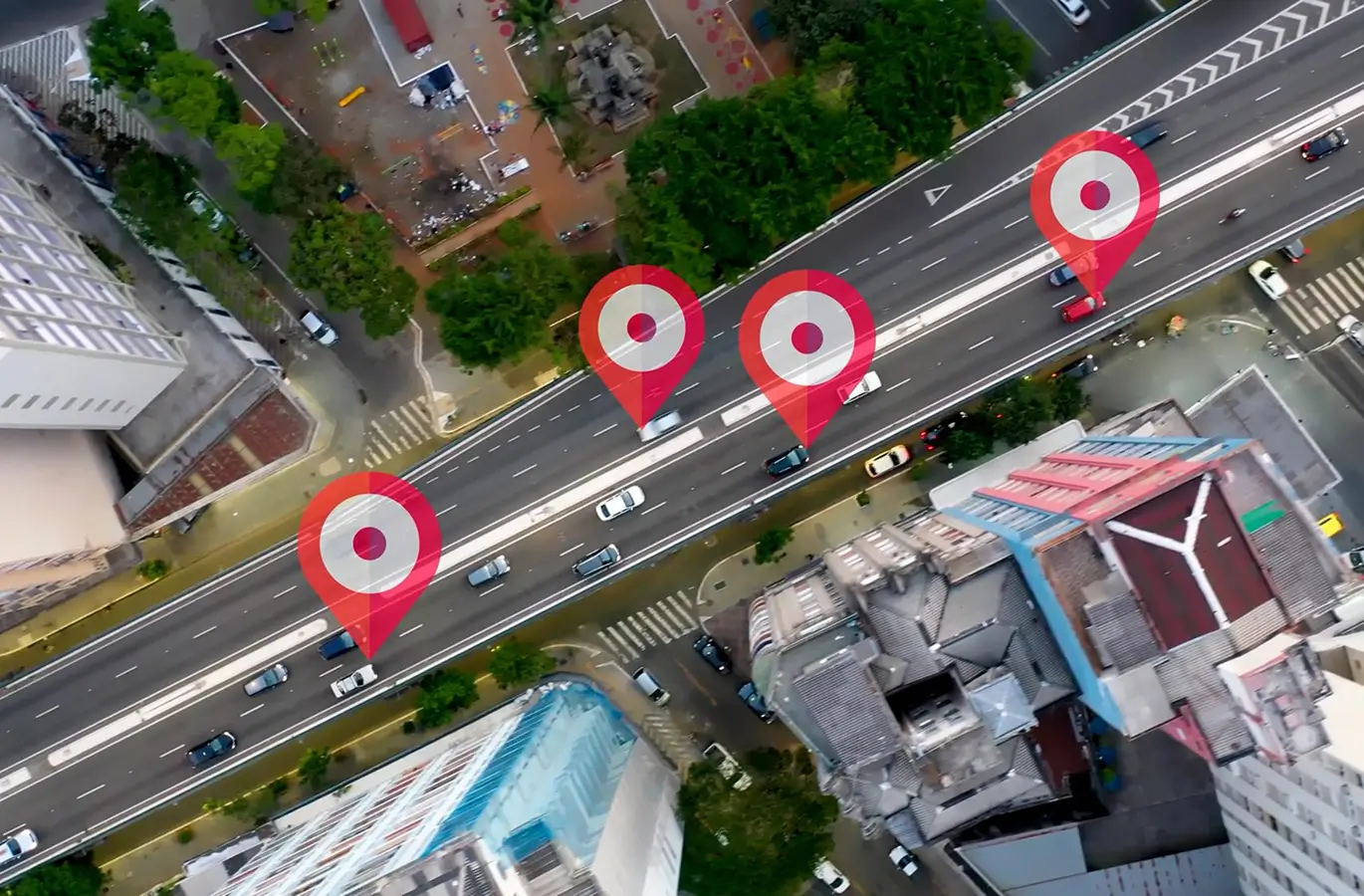Picture a fleet manager in 2005. GPS tracking had just started gaining traction. A map on the screen showed blinking dots, each representing a truck. It was useful, but limited. You knew where a vehicle was, but not whether it was road-ready, compliant, or about to miss a delivery window. Fast forward to today, and live location tracking has become the nerve center of fleet operations.
Now, fleets rely on real-time updates not only for dispatch and routing but also for safety, compliance, and customer visibility. Customers no longer accept vague delivery estimates. Drivers expect technology that protects them from false claims. Regulators demand accuracy and consistency in inspections. All of this converges on live tracking as the foundation for modern fleet management.
But the story does not stop here. The future of live location tracking holds even more promise. Artificial intelligence, predictive logistics, IoT integration, and transparent customer experiences will take it beyond knowing “where” into a new era of knowing “what next.” This article examines how live location tracking operates today, its significance, and its future direction as the technology continues to advance.
What Live Location Tracking Really Means
Live location tracking is not simply about placing a pin on a map. It involves the continuous monitoring of vehicles in real-time, capturing their movement, speed, and status, and linking that information to compliance and operational workflows. In 2026, it is less about static location and more about visibility that drives action.
Traditional GPS devices collect position data, but a live tracking system takes it a step further. It transmits that data instantly to a fleet platform, where it is analyzed and displayed in dashboards. Managers see not only where vehicles are but also if they have cleared inspections, whether service events are pending, and if they are compliant with regulatory standards.
This difference is critical. Basic GPS answers the question “where.” Live location tracking answers the questions “where, in what condition, and what should happen next.” That is why it has become the heartbeat of modern fleet operations. Without it, fleets are left reacting to problems. With it, they anticipate issues, plan smarter, and serve customers with confidence.
The Evolution of Fleet Visibility
Fleet tracking has advanced significantly over the past few decades. What started as a way to reduce guesswork about vehicle location has grown into a central tool for running entire operations. To understand where live location tracking is headed, it helps to see how far it has come.
The Early GPS Era
In the early 2000s, GPS tracking was a breakthrough. Managers could finally see where their vehicles were without having to call drivers for updates. These first systems were basic, providing location points but little else. While helpful, they still left big gaps in safety, compliance, and customer communication.
The Rise of Real-Time Tracking
By the mid-2010s, technology had advanced to provide live updates instead of static location logs. Dispatchers gained the ability to reroute vehicles in response to traffic or emergencies. Customers received more accurate delivery windows. Fleets began to reduce wasted miles and improve scheduling. This was the first step from dots on a map to true operational visibility.
Integration With Fleet Management
The next major shift occurred when live tracking data was integrated with compliance and service workflows. A vehicle was no longer just “here” on a map. It carried with it inspection history, defect reports, and maintenance status. This integration turned location into actionable insight. Fleets could anticipate downtime, avoid compliance penalties, and provide transparency to customers.
The Road Ahead
Today, fleets are entering a new phase where live location tracking is enhanced by artificial intelligence, predictive analytics, and IoT integration. It is no longer just about seeing the present. It is about forecasting what comes next — delays, risks, opportunities — and acting before they disrupt operations.
Evolution of Live Location Tracking

Current Benefits of Live Location Tracking
While the future is exciting, fleets are already experiencing powerful benefits from live location tracking today. It has become the backbone of operations because it solves problems that directly affect efficiency, compliance, and customer trust.
Smarter Dispatch and Rerouting
One of the most immediate advantages of live tracking is dispatch agility. When traffic jams, road closures, or urgent requests appear, managers can make real-time decisions. Instead of guessing or relying on driver updates, they see exactly where vehicles are and reroute accordingly. This keeps schedules intact and reduces costly delays.
Accurate ETAs for Customers
Customers no longer accept vague delivery windows. They expect precise updates that reflect reality on the road. Live location tracking provides accurate ETAs, allowing fleets to share real-time updates with shippers and clients. This transparency builds confidence and strengthens long-term relationships.
Protecting Drivers and Strengthening Safety
Safety is both a responsibility and a business priority. With live tracking, fleets can validate driver routes, confirm vehicle activity, and defend against false claims. If an incident occurs, managers have evidence that shows where and when it happened. This accountability protects drivers and reduces liability for the fleet.
Compliance Visibility
Compliance checks and roadside inspections can cause stress if records are scattered. With live tracking tied to inspection data, managers can instantly identify which vehicles are road-ready. If regulators request proof, the platform provides digital, timestamped records in minutes. This confidence makes compliance a routine rather than a reactive process.
A Real-World Example
Consider a delivery truck caught in heavy congestion near a city hub. Without live tracking, the dispatcher can only guess at the delay. With live tracking, the system highlights the slowdown, reroutes another nearby vehicle, and the customer receives an updated ETA. The package still arrives on time, the driver avoids stress, and the fleet maintains credibility.
The Future of Live Location Tracking
Live location tracking has already revolutionized the way fleets operate, but its future impact will be even more significant. The next generation of systems will not only report where vehicles are, but also provide insights into their behavior. They will predict what is likely to happen and guide managers toward the best decisions before issues occur.
AI-Enhanced ETAs and Predictive Logistics
Artificial intelligence is transforming live tracking from a tool for awareness into a system for foresight. Instead of simply showing delays, AI can analyze traffic patterns, weather, and historical data to predict when a vehicle is likely to arrive. Fleets will share these AI-enhanced ETAs with customers, reducing uncertainty and improving delivery performance.
IoT and Asset-Level Visibility
The Internet of Things will expand live location tracking beyond vehicles to every piece of equipment a fleet relies on. Trailers, containers, and even high-value tools can be tracked in real time. This provides full visibility across the supply chain, making it easier to manage assets, reduce theft, and optimize utilization.
Driving Sustainability Through Efficiency
Sustainability is becoming a major priority for fleets worldwide. Live location tracking will help reduce empty miles and cut fuel waste by optimizing routes in real time. Managers will use predictive visibility to plan journeys that minimize emissions while still meeting customer deadlines. Tracking will no longer be only about cost savings but also about supporting greener operations.
Customer Experience as a Differentiator
In a competitive logistics market, customer trust is everything. Live location tracking in the future will move closer to full transparency, where shippers and customers see the same live data that managers do. This shared visibility will build stronger relationships and make reliability a deciding factor in winning contracts.
From Reactive to Proactive Operations
The greatest change will be the shift from reacting to problems to preventing them. Fleets will no longer scramble when delays or defects arise. Instead, predictive live tracking will highlight risks in advance, allowing managers to adjust routes, schedule service, or notify customers before the issue escalates.
The Future of Live Location Tracking

Why REACH Leads the Future
The future of live location tracking will be shaped by platforms that go beyond simple visibility. Many systems stop at showing where vehicles are, while others add layers of features that create complexity without value. Fleets require a solution that strikes a balance between forward-looking innovation and everyday practicality. That is why REACH is defining the standard for live location tracking.
Hardware Flexibility
REACH does not require fleets to commit to a single type of device. Whether managers choose plug-and-play units for fast installation, hardwired devices for high-value assets, or solar-powered trackers for trailers, REACH integrates them all into one platform. This flexibility enables fleets to adopt live tracking in a manner that aligns with their assets, budgets, and long-term strategy.
Compliance Built Into Live Tracking
Location data alone does not guarantee readiness. REACH connects live tracking with inspection records and DVIRs, automatically creating audit-ready documentation. Managers see not just where vehicles are, but whether they are compliant and safe to operate. This integration shifts compliance from a stress point to a daily strength.
Turning Data Into Uptime
One of the most overlooked strengths of live tracking is its ability to protect uptime. REACH ensures that every inspection result flows directly into service workflows. Defects trigger service events automatically, managers track repairs in real-time, and vehicles return to operation faster. Uptime becomes predictable, which reduces costs and improves reliability.
Clear and Actionable Dashboards
Data only matters when it is actionable. REACH presents live location, compliance status, and service readiness in one view. Dispatchers know which vehicles are road-ready, service managers see repair progress, and customers receive ETAs backed by real-time data. The result is simpler decision-making and stronger trust.
Built for Today and Scalable for Tomorrow
Where many platforms promise future-ready features but lack practical value, REACH delivers both. It supports fleets today with compliance-first design and service digitization while also preparing them for tomorrow with integration capabilities that align with AI-driven logistics and IoT visibility.
The REACH Advantage
As live location tracking evolves, fleets need more than maps. They need a partner that turns visibility into compliance, uptime, and trust. REACH delivers this advantage by bridging daily operational needs with future growth opportunities. It is not just keeping up with the future of live location tracking. It is building it.
Conclusion: Live Location as the Fleet’s Future Backbone
Fleet operations no longer run on guesswork. Live location tracking has become the heartbeat of modern logistics, connecting vehicles, managers, drivers, and customers in real time. What began as simple GPS dots on a screen now shapes how fleets manage compliance, protect drivers, reduce downtime, and build customer trust.
The future is even more promising. Artificial intelligence, IoT integration, and predictive visibility will turn tracking into foresight. Fleets will know not just where vehicles are but what risks or opportunities lie ahead. This shift from reactive to proactive operations is what will separate leaders from laggards in the years to come.
REACH provides fleets with a future-ready platform today. With hardware flexibility, compliance-first workflows, and service digitization, it ensures live location tracking delivers both immediate ROI and long-term scalability. For fleets facing rising customer expectations and tightening regulations, REACH defines the future of live tracking by turning data into trust, uptime, and growth.
Key Takeaways
- Live location tracking has evolved from basic GPS into an integrated fleet management tool.
- Current benefits include smarter dispatching, accurate ETAs, stronger safety, and compliance confidence.
- The future brings AI-enhanced ETAs, IoT visibility, sustainability gains, and proactive decision-making.
- Live location tracking is becoming the backbone of fleet operations, not just an add-on.
- REACH leads this shift by combining present-day practicality with future-ready innovation.
Frequently Asked Questions (FAQs)
-
What is live location tracking in fleet operations?
Live location tracking is the continuous monitoring of vehicles in real time. It captures movement, speed, and status. It connects this data to compliance and service workflows, providing fleets with complete visibility and control over their operations.
-
How is live tracking different from GPS?
Basic GPS shows static location points. Live tracking provides real-time updates, integrates with inspections and service data, and delivers actionable insights instead of just location awareness.
-
What benefits does live tracking bring to fleets?
Benefits include smarter dispatching, accurate ETAs, improved safety, compliance visibility, and reduced downtime. These advantages directly strengthen customer trust and fleet profitability.
-
How does live tracking improve customer satisfaction?
By sharing accurate, real-time ETAs and transparent updates, live tracking builds confidence and reduces uncertainty. Customers know exactly when deliveries will arrive, improving reliability and trust.
-
What is the future of live tracking in logistics?
The future includes AI-enhanced ETAs, IoT visibility for trailers and equipment, predictive logistics, and sustainability gains through optimized routes and reduced fuel waste.
-
Why is REACH important for live location tracking?
REACH is hardware-agnostic, compliance-first, and designed to reduce downtime. It turns raw live tracking data into workflows that protect uptime, improve safety, and strengthen customer relationships.



